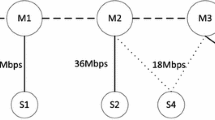Abstract
Wireless mesh networks (WMNs) provide high-bandwidth wireless access, which makes it capable for multimedia services. A user in a WMN may be covered by multiple APs, while it should be associated with only one to access the Internet. Conventional IEEE 802.11 user-AP association mechanism for WLANs employs signal strength as the sole metric. However, this may lead to network congestion and performance degradation in multi-hop networks such as WMNs, especially for multimedia services that require a large bandwidth and a low latency. Thus AP association in WMNs becomes an important research issue. In this paper we propose a novel AP association approach LBAA, taking AP’s load-balancing, WMN’s multi-hop characteristic, and user’s RSSI into consideration. We first propose a centralized algorithm and then extend it to a distributed one, with the latter one more practical and convenient for deployment. Network throughput and max–min user fairness are improved by LBAA. Performance evaluation demonstrating the benefits of our approach is given through a series of experiments in terms of collision probability, access bandwidth, end-to-end throughput, and average RSSI.
Similar content being viewed by others
References
Akyildiz F, Wang X, Wang W (2005) Wireless mesh networks: a survey. Comput Netw ISDN Syst 47(4):445–487
IEEE 802.11-1999, Part 11: wireless LAN medium access control (MAC) and physical layer (PHY) specifications. IEEE Std. (1999)
Balachandran A, Bahl P, Voelker GM (2002) Hot-spot congestion relief in public-area wireless networks. In: Proc IEEE MCSA’02, Callicoon, NY, USA, pp 70–80
Athanasiou G, Korakis T, Ercetin O, Tassiulas L (2009) A cross-layer framework for association control in wireless mesh networks. IEEE Trans Mob Comput 8:65–80
Coucheney P, Touati C, Gaujal B (2009) Fair and efficient user-network association algorithm for multi-technology wireless networks. In: INFOCOM 2009, the 28th conference on computer communications, IEEE 19–25, April 2009, pp 2811–2815
Ghini V, Cacciaguerra S, Lodi G, Panzieri F (2008) Enhancing mobile E-witness with access point selection policies. In: Proc of the fifth international conference on information technology: new generations
Bejerano Y, Han S-J, Li L (2004) Fairness and load balancing in wireless LANs using association control. In: Proc ACM MobiCom’04, Philadelphia, PA, USA, pp 315–329
Vasudevan S, Papagiannaki K, Diot C, Kurose J, Towsley D (2005) Facilitating access point selection in IEEE 802.11 wireless networks. In: Proc of ACM SIGCOMM/USENIX Internet measurement conference (IMC)
Taenaka Y, Kashihara S, Tsukamoto K, Yamaguchi S, Oie Y (2007) Terminal-centric AP selection algorithm based on frame retransmissions. In: Proc 2nd ACM workshop on performance monitoring and measurement of heterogeneous wireless and wired networks
Nicholson AJ, Chawathe Y, Chen MY, Noble BD, Wetherall D (2006) Improved access point selection. In: Proc 4th int conf mobile systems, applications and services (MobiSys), pp 233–245
Xie J, Howitt I (2009) Multi-domain WLAN load balancing in WLAN/WPAN interference environments. IEEE Trans Wirel Commun 8:4884–4894
Koutsopoulos I, Tassiulas PL (2007) Joint optimal access point selection and channel assignment in wireless networks. In: IEEE/ACM Transactions on Networking (TON)
Jardosh AP, Mittal K, Ramachandran KN, Belding EM, Almeroth KC (2006) IQU: practical queue-based user association management for WLANs. In: Proc ACM MobiCom’06, Los Angeles, California, USA, pp 158–169
Guo F, Chiueh T (2005) Scalable and robust WLAN connectivity using access point array. In: Proc international conference on dependable systems and networks (DSN), pp 288–297
Mittal K, Belding E, Suri S (2006) A game-theoretic analysis of wireless access point selection by mobile users. Technical report, University of California, Santa Barbara
IEEE 802.11 WG (2008) Draft standard: wireless LAN medium access control (MAC) and physical layer (PHY) specifications—amendment 1: radio resource measurement of wireless LANs. IEEE 802.11k/D13.0, New York, USA
Garcia Villegas EG, Vidal Ferré R, Paradells Aspas J (2006) Load balancing in WLANs through IEEE 802.11k mechanisms. In: Proc the 11th IEEE symposium on computers and communications (ISCC’06)
Luo L, Liu H, Wu M, Li D (2008) End-to-end performance aware association mechanism for wireless municipal mesh networks. Computer Communications
Makhlouf S, Chen Ye, Emeott S, Baker M (2008) A network-assisted association scheme for 802.11-based mesh networks. In: Proc IEEE WCNC, pp 1339–1343
Athanasiou G, Korakis T, Ercetin O, Tassiulas L (2008) Dynamic cross-layer association in 802.11-based mesh networks. In: Proc IEEE INFOCOM’07, Anchorage, AK, USA, May 2007, pp 2090–2098
Kumar A, Altman E, Miorandi D, Goyal M (2005) New insights from a fixed point analysis of single cell IEEE 802.11 wireless LANs. Technical report RR-5218, INRIA, Sophia-Antipolis, France, June 2004. Conference version to appear in IEEE Infocom 2005
Bianchi G (2000) Performance analysis of the IEEE 802.11 distributed coordination function. IEEE J Sel Areas Commun 18(3):535–547
Lovász L, Plummer MD (1986) Matching theory. North-Holland, Amsterdam; ISBN 0444879161
Wang S, Cui Y, Xu K, Wu J, Ping Y (2009) Cell breathing based on supply-demand model in overlapping WLAN cells. In: The 6th ACM conference on heterogeneous networking for quality, reliability, security and robustness (ACM Qshine2009), Las Palmas de Gram Canaria, Spain, pp 203–217
Song W, Zhang W, Cheng Y (2007) Load balancing for cellular/WLAN integrated networks. IEEE Netw 21(1):27–33
Gong H, Nahm K, Kim J (2008) Distributed fair access point selection for multi-rate IEEE 802.11 WLANs. IEICE Trans Inf Syst E91-D(4):1193–1196
Abramowitz M, Stegun I (2002) Handbook of mathematical functions
Chavoutier V, Maniezzo D, Palazzi CE, Gerla M (2007) Multimedia over wireless mesh networks: results from a real testbed evaluation. In: The sixth annual Mediterranean ad hoc networking workshop, Corfu, Greece, June 12–15, 2007
Biggs N, Lloyd E, Wilson R (1986) Graph theory. Oxford University Press, Oxford
Author information
Authors and Affiliations
Corresponding author
Rights and permissions
About this article
Cite this article
Cui, Y., Ma, T., Liu, J. et al. Load-balanced AP association in multi-hop wireless mesh networks. J Supercomput 65, 383–409 (2013). https://doi.org/10.1007/s11227-010-0519-7
Published:
Issue Date:
DOI: https://doi.org/10.1007/s11227-010-0519-7




